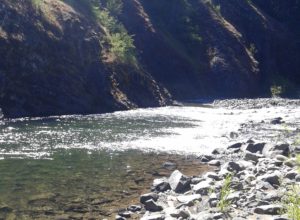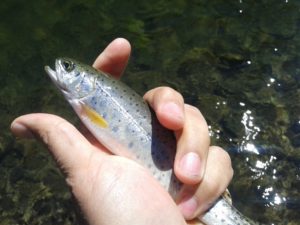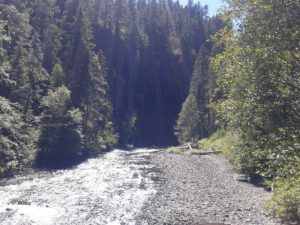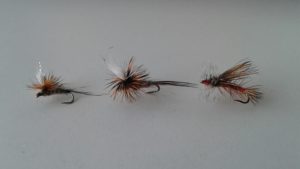I can’t let certain things go for too long. If it is part of some project I am trying for the first time, or a goal I set that I was not able to finish, it gnaws at me until I can at least re-engage with it. It’s not that I have to get it completely done, but progress must be made.
Last week, when the arrival of lightning above the river brought an unexpected end to the day on two rivers, my intent had been to make my way across a rock face, into a great casting position that I have tried, previously. Since then, of course, I have had that nagging thought in the back of my mind…”is that spot still just as good?”
Yesterday, having been up and responding to work emails at around 6am, and a solid day of work accomplished by mid-afternoon, I had my chance to pick up that train of thought, and give it another try. On a bright and sunny drive, I was struck by the fact that I had also still never tried another Naches tributary that I pass each time I head up the river – Rattlesnake Creek.

It reportedly has some great Cutthroat fishing, especially in the upper reaches where you have to travel by jeep trail or rough roads, and avoid washouts in some sections.Sounds like a nice challenge. Some sources also point heavily to there being a reason it carries this name, and also to occasional black bear sightings, so caution is warranted.
Another time…
I pulled up to the river, after the roughly hour drive, noting that the outside air temp on the truck was saying 68 degrees. Great temp for fishing on a sunny day!
As I arrived at the pool where we had left off, last time, I waded out a few feet from shore. The river proved to be roughly 10 degrees cooler than the air, but that’s tolerable for wet wading. The breeze, on the other hand…tried to cause problems. At home, the online weather reports indicated 4-5 mph breezes. In such a narrow canyon, that gets magnified when the wind and the canyon align. Today was one of those days, so I expected to get some sidearm casting practice in.

The rock face with the footholds and ledges is off to the left, just outside of this picture. I took a look at it, then decided that I would save it for the end of the trip. As I pondered this, though, I also became aware of some medium-sized, reddish insects that were descending to the water, tapping the surface, then flitting away.
Excellent!
Could be Caddis or some kind of Mayfly, but that kind of activity can really stir up the trout. As I started to feed out line, to allow me to drop my #14 rusty Parachute Adams into what I thought would be a good spot… *Splash*…a cutthroat jumped up through the surface film, in an attempt to catch one of the egg-laying insects as it lifted back up!
Seeing the insect activity is an encouraging sign…seeing the response was thrilling. When the young trout get that excited, it can be an excellent day on any river!
I worked the near side of the seam line, the outflow of bubbles and debris that washes down stream from the riffles, and had my first hookup within 5 minutes! It was small, and I let it slip the hook with some slack line, but what a great start! Moving closer to the edge of the water cascading into the pool, I had my second a few minutes later!

I fished around that pool a bit more, and got a few splashy refusals from other fish, as well. My Parachute Adams was getting quite a bit of attention and I still occasionally saw fish jumping in other areas. I wanted to let the pool rest a bit, before making my way back to it, and crossing the rock face, so I moved out to the middle of the riffles, then turned upstream.
Heading up the flow, I began casting as I worked my way from pocket to pocket, looking for the occasional larger slick, behind protruding rocks. I often have good success in pocket water and riffles, and today was no exception to that. I had two more hookups as I moved through this stretch, and into a longer run that has historically not been very productive for me.

Not sure why I usually don’t see many fish in this area, but I went through a bit more patiently, and worked on casing accuracy. The wind had died down as I came up through the riffles, subdued now and gently flowing downstream. Today, this run had me connect with two more Cutts! One of them took the fly as I let it simply drift behind me, as I shifted to a new standing position.
Have to appreciate those “volunteers” that offer you this kind of surprise!
Arriving at the bend in the river (this one coming in from the left, running into the rock face below the access road, then turning sharp right to the top of the run and continuing parallel to the road), I took a moment to switch to a #12 Parachute Adams, that is tied large, with extra hackle and a thick body. The water churning at this bend was making the first fly hard to see, and I wanted to make sure to offer up a bigger meal, to see if it would improve the frequency of connecting with those splashy refusals I was still seeing with regularity.
Sure enough; one more out of the bend in the river!
I followed the leftward turn, made my way across the flow of the water, and moved a bit upstream. This section has a gorgeous rock wall on the left side of the river and a pool that I have not tried since early last year. It also has a narrow riffle above that pool, to which I have not yet waded…

I connected with one more trout, as I made my way upstream, but noticed that the shadows were getting longer, across the water. The first pool…and that rock face…were calling to me and I did not want to delay much longer. I reeled in my line, and gently exited the water to make my way back down to where I had started the day.
Arriving back at the spot, I slipped into the current farther downstream, and made my way tot he far side. That stretch has a deeper trough on the far side, but one has to wade through to get to the area where the horizontal climbing can start. For water that is below 60, getting into depths where the lower half of your pant pockets are submerged is a bit of a test, but the goal is in sight the entire time! Doesn’t hurt that I connected with yet another trout as I was making my way across!
I reached the low point in the rock face, and started the mostly horizontal climbing. The small outcroppings and ledges allow for moving to the side with only a few places where one has to really extend to find the next solid shelf, and you move no more than 2-3′ up or down the rock face, as you go. Also a few spots where one can pause, cast, and gauge the flow of the river, just below you. Still quite a few splashes…and another hookup!
When I got to the bend in the rock face, I easily found the same footholds I had used int he previous year. With a 9′ rod, this spot allows me to cast directly upstream into the tongues of water pouring over the right end of the bottom of the riffles, but also to reach out a bit and cast lengthwise down the pool that is formed at the bottom of the rock face. The angle your fly arrives at, assuming some slack is thrown into the cast, allows for several feet of great drift. I had several more hookups, from here, even with a switch to a #12 Orange Stimmy!
In the middle of a back cast, I felt a sudden change in the weight and balance of my rod. Thinking it a snag on some rock-clinging plant, I shifted around…to discover that the upper half of the rod had separated and was lying in the water, below me! Not something I have had happen, before, but a great reminder to seat the sections together with the right amount of force, and re-check every now and then. Luckily, the fly in use was large enough that it could not pull back through the tip, so bringing up the line carried the section of the rod with it. As I was reassembling the rod, the Stimmy dragged across the water a bit…and had a fish jump up to try to grab it. For a few minutes, after that, I tried “dapping” the fly across the surface film, in imitation of the egg laying of the reddish insects, and actually got quite a bit of attention. At one point, I could clearly see, due to the high vantage point, a large trout bolt from hiding next to a good-sized rock and fire up at the bouncing fly like a torpedo. It changed course within the last few inches, bubbling up the surface, and returned to the rock, but what a thrill to see the entire path it took!
By end of day, I had used three different flies, and hooked almost a dozen fish! More than half were smaller, and I let them off with slack in the line, but some had hooked themselves too well, or we large enough that I did not feel bad taking the opportunity to see them up close.

Great day on a beautiful river.
Tight lines!
